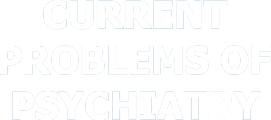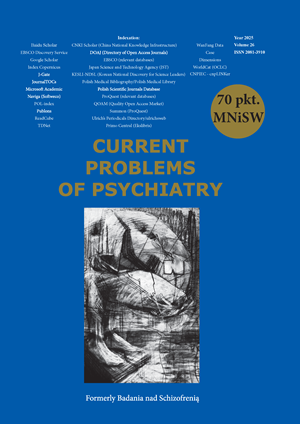Związki cech autystycznych z wczesnymi nieadaptacyjnymi schematami J. Younga
DOI:
https://doi.org/10.12923/2353-8627/2025-0005Słowa kluczowe:
wczesne nieadaptacyjne schematy, zaburzenia ze spektrum autyzmu, cechy autystyczneAbstrakt
Wstęp: Powiązania pomiędzy nasileniem cech autystycznych a zmiennymi, takimi jak wczesne nieadaptacyjne schematy (early maladaptive schemas, EMS) nie były do chwili obecnej szeroko badane. Celem prezentowanego badania jest ocena różnic w natężeniu poszczególnych EMS pomiędzy osobami z diagnozą zaburzeń ze spektrum autyzmu (autism spectrum disorder, ASD) i osobami bez tej diagnozy oraz sprawdzenia, czy wyższemu natężeniu cech autystycznych w grupie ASD towarzyszy wyższe natężenie poszczególnych wczesnych nieadaptacyjnych schematów.
Materiał i metody: W badaniu wzięły udział 102 osoby w wieku 18 – 49 lat (średni wiek: M = 29,47; SD = 7,79), w tym 51 osób z diagnozą ASD oraz 51 osób nie leczonych z powodu zaburzeń psychicznych z I lub II osi. Badani wypełniali zestaw następujących narzędzi: Kwestionariusz AQ, Kwestionariusz schematów Younga (YSQ-S3-PL), ankietę socjodemograficzną.
Wyniki: Średni wynik dla kwestionariusza AQ, mierzącego natężenie cech autystycznych to 30,14 (dla grupy osób z diagnozą ASD). Osoby z diagnozą ASD uzyskały wyższe wyniki w czterech z pięciu obszarów wczesnych nieadaptacyjnych schematów. Wyjątek stanowi domena – Nakierowanie na innych. Badani z diagnozą ASD uzyskali również wyższe wyniki w większości EMS. Istotność statystyczną stwierdzono w przypadku dwóch schematów – Izolacji społecznej (p=0,0002*) oraz Zahamowania emocjonalnego (p=0,015). Istotne statystycznie zależności pomiędzy natężeniem cech autystycznych i domenami EMS dotyczą domen (od najsilniejszego związku): Nadmierna czujność i zahamowanie, Rozłączenie / odrzucenie oraz Osłabiona autonomia i brak dokonań. Wśród poszczególnych schematów (od najsilniejszego związku): Izolacja społeczna, Zahamowanie emocjonalne, Nadmierne wymagania, Zależność/Niekompetencja, Podatność na zranienie lub chorobę, Bezwzględna surowość/Punitywność, Negatywizm/Pesymizm oraz Wadliwość/Wstyd.
Wnioski: 1. Osoby z diagnozą ASD w porównaniu do grupy porównawczej prezentują istotnie wyższe natężenie dwóch spośród wczesnych nieadaptacyjnych schematów: Izolacji społecznej oraz Zahamowania emocjonalnego. 2. Natężenie cech autystycznych w grupie z diagnozą ASD jest powiązane tak z natężeniem domen, jak i schematów odnoszących się szczególnie do izolacji społecznej i reakcji emocjonalnych.
Bibliografia
1. Hirota T & King BH. Autism Spectrum Disorder: A Review. JAMA, 2006; 329(2), 157-168. https://doi.org/10.1001/jama.2022.23661.
2. Salari N, Rasoulpoor S, Rasoulpoor S, Shohaimi S, Jafarpour S, Abdoli N, et al. The global prevalence of autism spectrum disorder: a comprehensive systematic review and meta-analysis. Ital J Pediatr, 2022; 48(112), 1-16. https://doi.org/10.1186/s13052-022-01310-w
3. Danielewicz D. Adults with autism spectrum disorders – specificity of functioning, needs, limitations, possibilities. Educ Psychol, 2022; 66(24):23-35. https://doi.org/10.5604/01.3001.0016.0962
4. Jensen de López K, Thirup Møller H. Prevalence of Autism in Scandinavian Countries (Denmark, Norway, Sweden), and Nordic Countries (Finland, Iceland, the Faroe Islands, and Greenland). Neuropsychiatr Dis Treat, 2024, 20:1597-612. https://doi.org/10.2147/ndt.s466081
5. Fombonne E. Epidemiology of Pervasive Developmental Disorders. Pediatr Res, 2009; 65(6):591-8. https://doi.org/10.1203/pdr.0b013e31819e7203
6. Loomes R, Hull L, Mandy WP. What Is the Male-to-Female Ratio in Autism Spectrum Disorder? A Systematic Review and Meta-Analysis. J Am Acad Child Amp Adolesc Psychiatry, 2017; 56(6):466-74. https://doi.org/10.1016/j.jaac.2017.03.013
7. Hayes J, Ford T, Rafeeque H, Russell G. Clinical practice guidelines for diagnosis of autism spectrum disorder in adults and children in the UK: a narrative review. BMC Psychiatry. 2018 doi: 10.1186/s12888-018-1800-1.
8. American Psychiatric Association (APA). Diagnostic and Statistical Manual of Mental Disorders (DSM¬5), 2013, American Psychiatric Publishing. https://doi.org/10.1176/appi.books.9780890425596
9. Rynkiewicz A, Kulik M. Wystandaryzowane, interaktywne narzędzia do diagnozy zaburzeń ze spektrum autyzmu a nowe kryteria diagnostyczne DSM-5. Via Medica, 2013; 10(2), 41-48.
10. American Psychiatric Association (APA). Diagnostic and Statistical Manual of Mental Disorders (DSM-IV), 1994; American Psychiatric Publishing.
11. World Health Organization. International Classification of Diseases 11th Revision. The global standard for diagnostic health information. Pobrano z: https://icd.who.int/en (dostęp z dn. 09.07.2024).
12. Gaebel W, Zielasek J, Reed G. Zaburzenia psychiczne i behawioralne w ICD-11: koncepcje, metodologie i obecny status. Psychiatr Polska, 2017; 51(2), 169-195. https://doi.org/10.12740/pp/69660
13. Reed GM, First MB, Kogan CS, Hyman SE, Gureje O, Gaebel W, et al. Innovations and changes in the ICD-11 classification of mental, behavioural and neurodevelopmental disorders. World Psychiatry, 2019; 18(1):3-19. https://doi.org/10.1002/ wps.20611
14. Grzegorzewska I, Pisula E, Borkowska AR. Psychologia kliniczna dzieci i młodzieży. W: Cierpiałkowska L, Sęk H. red., Psychologia kliniczna. Polskie Wydawnictwo Naukowe: 2020: 451-496.
15. Masi A, DeMayo MM, Glozier N, Guastella AJ. An Overview of Autism Spectrum Disorder, Heterogeneity and Treatment Options. Neurosci Bull, 2017; 33(2):183-93. https://doi.org/10.1007/s12264-017-0100-y
16. Herbert MR., Ziegler DA., Deutsch CK., O'Brien LM., Lange N., Bakardjiev A., Hodgson J., et al. Dissociations of cerebral cortex, subcortical and cerebral white matter volumes in autistic boys. Brain, 2003; 126(5), 1182-1192. https://doi.org/10.1093/ brain/awg110
17. Stanfield AC, McIntosh AM, Spencer MD, Philip R, Gaur S, Lawrie SM. Towards a neuroanatomy of autism: A systematic review and meta-analysis of structural magnetic resonance imaging studies. Eur Psychiatry, 2008; 23(4): 289-99. https://doi.org/10.1016/j.eurpsy.2007.05.006
18. Chan MM, Han YM. Differential mirror neuron system (MNS) activation during action observation with and without social-emotional components in autism: a meta-analysis of neuroimaging studies. Mol Autism, 2020;11(1). https://doi.org/10.1186/s13229-020-00374-x
19. Vuijk R, Turner W, Zimmerman D, Walker H, Dandachi-FitzGerald B. Schema therapy in adults with autism spectrum disorder: A scoping review. Clin Psychol Amp Psychother, 2024. https://doi.org/10.1002/cpp.2949
20. Oshima F, Murata T, Ohtani T, Seto M, Shimizu E. A preliminary study of schema therapy for young adults with high-functioning autism spectrum disorder: a single-arm, uncontrolled trial. BMC Res Notes, 2021;14(1). https://doi.org/10.1186/s13104-021-05556-1
21. Arntz A, Jacob G. Terapia schematów w praktyce. Praca z trybami schematów. Gdańskie Wydawnictwo Psychologiczne: 2016.
22. Fassbinder E, Arntz A. Terapia schematów. W: A. Wenzel (red.), Handbook of cognitive behavioral therapy: Overview and approaches. APA: 2021: 493-537. https://doi.org/10.1037/0000218-017
23. Young J, Klosko JS, Weishaar ME. Terapia schematów. Przewodnik praktyka. Gdańskie Wydawnictwo Psychologiczne: 2013.
24. Pilkington PD, Karantzas GC, Faustino B, Pizarro-Campagna E. Early maladaptive schemas, emotion regulation difficulties and alexithymia: A systematic review and meta-analysis. Clin Psychol Amp Psychother, 2023. https://doi.org/10.1002/cpp.2914
25. Bär A, Bär HE, Rijkeboer MM, Lobbestael J. Early Maladaptive Schemas and Schema Modes in clinical disorders: A systematic review. Psychol Psychother, 2023. https://doi.org/10.1111/papt.12465
26. Dostal AL, Pilkington PD. Early maladaptive schemas and obsessive-compulsive disorder: A systematic review and meta-analysis. J Affect Disord, 2023; 336:42-51. https://doi.org/10.1016/j.jad.2023.05.053
27. Bishop A, Younan R, Low J, Pilkington PD. Early maladaptive schemas and depression in adulthood: A systematic review and meta-analysis. Clin Psychol Amp Psychother, 2021. https://doi.org/10.1002/cpp.2630
28. Dapretto M, Davies MS, Pfeifer JH, Scott AA, Sigman M, Bookheimer SY, et al. Understanding emotions in others: mirror neuron dysfunction in children with autism spectrum disorders. Nat Neurosci, 2006; 9(1), 28-30. https://doi.org/10.1038/nn1611
29. Sanchack KE, Thomas CA. Autism Spectrum Disorder: Primary Care Principles. Am Fam Physician. 2016; 94(12): 972-979.
30. Vuijk R, Deen M, Geurts HM, Arntz A. Schema therapy for personality disorders in autistic adults: Results of a multiple case series study. Clin Psychol Psychother. 2023 Mar;30(2):458-472. doi: 10.1002/cpp.2817.
31. Oshima F, Nishinaka H, Iwasa K, Ito E, Shimizu E. Autism Spectrum Traits in Adults Affect Mental Health Status via Early Maladaptive Schemas. J Psychol Res, 2014;4(05).https://doi.org/10.17265/2159-5542/2014.05.002
32. Baron-Cohen S, Wheelwright S, Skinner R, Martin C, Clubley E. (2001). The Autism-Spectrum Quotient (AQ): Evidence from Asperger Syndrome/High Functioning Autism, Males and Females, Scientists and Mathematicians. J Autism Dev Disord, 2001; 31(1), 5-17.
33. Pisula E, Kawa R, Szostakiewicz R, Łucka I, Kawa M, Rynkiewicz (2013). Autistic Traits in Male and Female Students and Individuals with High Functioning Autism Spectrum Disorders Measured by the Polish Version of the Autism Spectrum Quotient. PLoS ONE, 2013; 8(9), 1-12. https://doi.org/10.1371/journal.pone.0075236
34. Wheelwright S, Auyeung B, Allison C, Baron-Cohen S. Defining the broader, medium and narrow autism phenotype among parents using the Autism Spectrum Quotient (AQ). Mol Autism, 2010;1(1):10. https://doi.org/10.1186/2040-2392-1-10
35. Young J. Young Schema Questionnaire – Short Form 3 (YSQ-S3). Cognitive Therapy Center: 2005.
36. Oetingen J, Chodkiewicz J, Mącik D, Gruszczyńska E. Polish adaptation of the The Young Schema Questionnaire 3 Short Form (YSQ-S3-PL). Psychiatr Polska, 2018;52(4):707-18. https://doi.org/10.12740/pp/onlinefirst/76541
37. Kunst H, Lobbestael J, Candel I, Batink T. Early maladaptive schemas and their relation to personality disorders: A correlational examination in a clinical population. Clin Psychol Psychother. 2020; 27(6): 837–846. Published online 2020 Jun 17. doi: 10.1002/cpp.2467
38. Lord C, Elsabbagh M, Baird G, Veenstra-Vanderweele J. Autism spectrum disorder. Lancet 2018; 392(10146): 508–520. https://doi.org/10.1016/S0140-6736(18)31129-2
39. Oshima F, Iwasa K, Nishinaka H, Shimizu E. (2015). Early Maladaptive Schemas and Autism Spectrum Disorders in Adults. Journal of Evidence-Based Psychotherapies, 2015;15(2), 191-205.
40. Pilkington PD, Bishop A, Younan R. Adverse childhood experiences and early maladaptive schemas in adulthood: A systematic review and meta-analysis. Clin Psychol Psychother. 2021;28(3):569-584. https://doi.org/10.1002/cpp.2533.
41. Janovsky T, Rock AJ, Thorsteinsson EB, Clark GI, Murray CV.The relationship between early maladaptive schemas and interpersonal problems: A meta-analytic review. Clin Psychol Psychother. 2020; 27(3):408-447. https://doi.org/10.1002/cpp.2439.
42. Hume K, Steinbrenner JR, Odom SL, Morin KL, Nowell SW, Tomaszewski B, Szendrey S, McIntyre NS, Yücesoy-Özkan S, Savage MN. Evidence-Based Practices for Children, Youth, and Young Adults with Autism: Third Generation Review. J Autism Dev Disord. 2021 Nov;51(11):4013-4032. https://doi.org/10.1007/s10803-020-04844-2.
43. Genovese A, Butler MG. The Autism Spectrum: Behavioral, Psychiatric and Genetic Associations. Genes (Basel). 2023 Mar 9;14(3):677. https://doi.org/10.3390/genes14030677.
44. Spicer L, DeCicco E, Clarke A, Ambrosius R, Yalcin O. Understanding early maladaptive schemas in autistic and ADHD individuals: exploring the impact, changing the narrative, and schema therapy considerations. Front Psychol. 2024; 15: 1436053. https://doi.org/10.3389/fpsyg.2024.1436053
45. Kamio Y, Inada N, Koyama T. A nationwide survey on quality of life and associated factors of adults with high-functioning autism spectrum disorders. Autism. 2013 Jan;17(1):15-26. https://doi.org/10.1177/1362361312436848.
46. Hull L, Petrides KV, Mandy W. The Female Autism Phenotype and Camouflaging: a Narrative Review. Rev J Autism Dev Disord, 2020;7(4):306-17. https://doi.org/10.1007/s40489-020-00197-9
47. Bernardin CJ, Lewis T, Bell D, Kanne S. Associations between social camouflagingand internalizing symptoms in autistic and non-autistic adolescents. Autism, 2021; 25(6), 1580–1591. https://doi.org/10.1177/1362361321997284.
48. Green RM, Travers AM, Howe Y, McDougle CJ. Women and Autism Spectrum Disorder: Diagnosis and Implications for Treatment of Adolescents and Adults. Curr Psychiatry Rep. 2019;21(4):22. https://doi.org/10.1007/s11920-019-1006-3.
49. Kimber L, Verrier D, Connolly S. Autistic People's Experience of Empathy and the Autistic Empathy Deficit Narrative. Autism Adulthood, 2023. https://doi.org/10.1089/aut.2023.0001
50. Cardoso BLA, Lima AFA, Costa FRM, Loose C, Liu X, Fabris MA. Sociocultural Implications in the Development of Early Maladaptive Schemas in Adolescents Belonging to Sexual and Gender Minorities. Int J Environ Res Public Health. 2024;21(8):971. https://doi.org/10.3390/ijerph21080971.
51. Lai MC, Kassee C, Besney R, Bonato S, Hull L, Mandy W, Szatmari P, Ameis SH. Prevalence of co-occurring mental health diagnoses in the autism population: a systematic review and meta-analysis. Lancet Psychiatry. 2019;6(10):819-829. https://doi.org/10.1016/S2215-0366(19)30289-5.
Pobrania
Opublikowane
Numer
Dział
Licencja
Prawa autorskie (c) 2025 Autorzy

Utwór dostępny jest na licencji Creative Commons Uznanie autorstwa 4.0 Międzynarodowe.


